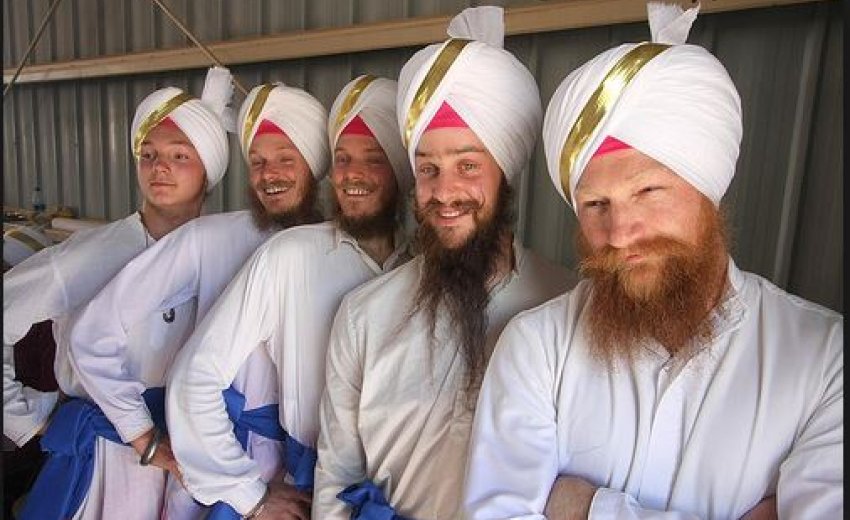 Sword-carrying Sikhs roaming the Indian city of Amritsar are a normal sight; but white people wearing turbans definitely are not. The strangeness lies in the fact that they are non-Indians who converted to Sikhism.
Sword-carrying Sikhs roaming the Indian city of Amritsar are a normal sight; but white people wearing turbans definitely are not. The strangeness lies in the fact that they are non-Indians who converted to Sikhism.
Most of them attend the Miri Piri Academy (MPA), an International boarding school in Amritsar where foreigners who converted to Sikhism leave their children to immerse themselves in the religion. And don’t let the teacher’s name, Mahan Atma Kaur, mislead you. She is Svetlana, a Russian-American national who has been teaching there for two years.
The 34-year-old white Sikh converted in 2004 and changed her name to Mahan Atma, which means “greatest soul” in the Indian language.
Why? “It feels to me that I did not 'choose' to be a Sikh. We all are Sikhs, as 'seekers of the truth'. As soon as I felt my heart’s yearning for the guru’s word, I knew it was my path. It is my life,” Mahan told RTV during an interview.
The current student body represents 13 countries and 8 languages from various countries in Asia, Europe and America.
Although Sikhism does not have missionaries around the world, more white people are converting to Sikhism in the 21st century. Sikhism as a faith has never actively sought converts, thus the Sikhs have remained a relatively homogeneous racial group.
Why Sikhism?
After the September 11 attacks, some people associated Sikhs with terrorists or members of the Taliban. Research suggests there has been an increase in hate-crimes against Sikh men in America and England. Still, there has been an increase in the number of foreigners who convert to Sikhism. Why?
Gurusewak Singh Khalsa, who was born to parents of American/European descent, told RTV via email, “Some might say Sikhism is a strict religion. At first glance this makes sense – physically, men have beards, wear turbans and kirpans (knives), and women don't cut their hair.”
“But once one sees past the physical I have found that there is a lot more openness, freedom, and acceptance in the Sikh teachings compared to other religions,” he added.
Amrit Kaur does not look like a Punjabi in any way, but practices Sikhism. Born in Toronto, Canada, her mother was an atheist and her father was Catholic.
“I researched many religions and practiced different ones… but nothing 'belonged' to me. It wasn't until the summer of 2004, when I first met a Sikh, that I learned about the existence of Sikhism,” she writes in her blog ( amritkaur.blogspot.com).
We talked to Dana Singh, who calls herself "gora (white) Sikh" and is dedicated to the cause of Sikhism. Born in Latvia (former USSR), she met her Sikh husband in Ireland, and he introduced her to his culture and religion. Though she has not formally converted to Sikhism, she still considers herself a Sikh.
“Earlier I had never heard about Sikhism and wasn't aware that this is the fifth largest religion in the world. We married in Amritsar in a traditional ceremony. It was so different from European weddings – like a fairy tale,” she revealed in an interview.
Ask her why she chose to live her life as a Sikh and she replies, “I didn't convert formally but just live and learn everyday more and more about Sikhism.”
Conversion Through Kundalini Yoga
Due to the activities of Harbhajan Singh Yogi via his Kundalini Yoga, which focuses on 3HO (Happy, Healthy, Holy) Organization, Sikhism has witnessed a moderate growth in non-Indian adherents.
It was estimated that in 1998, these 3HO Sikhs, known colloquially as “gora” or “white” Sikhs, totalled 7,800 members, and were mainly centered around Española, New Mexico and Los Angeles, California.Most foreigners turn to Sikhism through an indirect route of Kundalani Yoga from Harbhajan Singh Khalsa, better known as Yogi Bhajan, a renowned Sikh yoga teacher who came to America in the late 1960s, and died in 2004.
After the death of Yogi Bhajan, the U.S. Congress passed a bipartisan resolution honoring his life and work, thus equating his life with a select few – Dr. Martin Luther King Jr., Mother Theresa, and Pope John Paul II.
Like her teacher Yogi Bhajan, Mahan Atma Kaur, a psychology major from St.-Petersburg State University in Russia, also teaches Kundalini yoga. “I decided to move to the U.S. and came in contact with Yogi Bhajan. As I started my daily Kundalini Yoga practice, I found an experience of God within me; it has enriched my life and opened my heart.”
Ask Mahan how her family reacted to her “transition” and she says that her mother was “very supportive and said ‘I don't understand what it is, but whatever it is you do, it makes you great! You are as clear and pure as crystal!’"
The most obvious effect of Kundalani Yoga can be seen in Espanola, New Mexico, where Yogi Harbhajan Singh lived. There are about 50 yoga centres in the state of New Mexico, and a number of people have converted to Sikhism.
Conversion
The views on conversion from one religion to another are varied. Brij Bedi, a social activist from Amritsar and a descendant of Guru Nanak Dev (the Sikhs' first guru), said in a telephone interview, “Be it Islam, Christianity, Hinduism or Sikhism, all religions teach the same principles of equality, non-violence, faith, selflessness and love towards humanity.”Ethelred, a member at a public forum (stormfront.org) writes, “Most people convert because they're told to be ashamed of their own culture and history. All I know is I'd die before converting to either.”
Matt Borghese, a content writer based in Florida, said in a telephone interview that the “third world religions are catching on in the first world. Who would have thought it? That is a growing trend in the U.S. I see white guys in Sikh turbans all the time.”
“One I saw over the weekend had a white turban and bright red beard. I don't see the appeal in those two religions myself,” he added.
Famous White Sikhs In History
Historically, the phenomenon of conversion of whites to Sikhism is centuries old. Max Arthur Macauliffe (1841-1913), a senior British administrator who was posted to India during the British rule of Punjab, converted to Sikhism in the 1860s. As a prolific scholar and author, Macauliffe is held in high esteem among the Sikh community, in particular the intelligentsia, for his monumental translation into English of the Sikh Scriptures, the Guru Granth Sahib.
In more recent times, earlier examples of conversion includes Vic Briggs, a 64-year-old London resident and former blues musician (The Animals). He converted and took the name Vikram Singh Khalsa. Later, he became the first non-subcontinental to perform religious chants at the Golden Temple.
Dr. Lonnie Smith, a 67-year-old New York resident, is a jazz musician, recognized as an exceptional player of both the Hammond B3 organ and piano, also converted to Sikhism but did not change his name.

